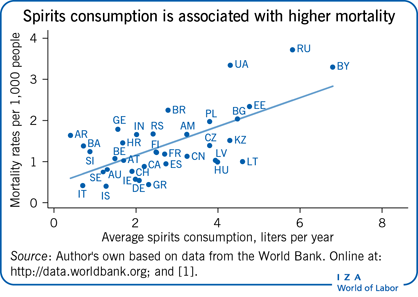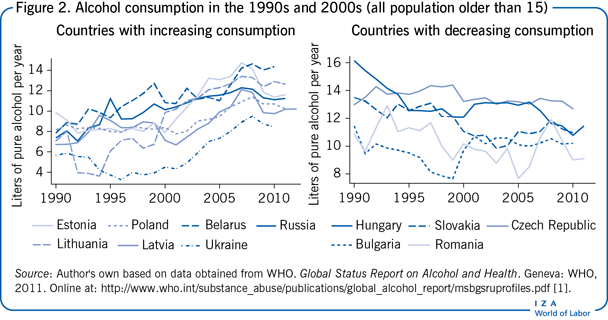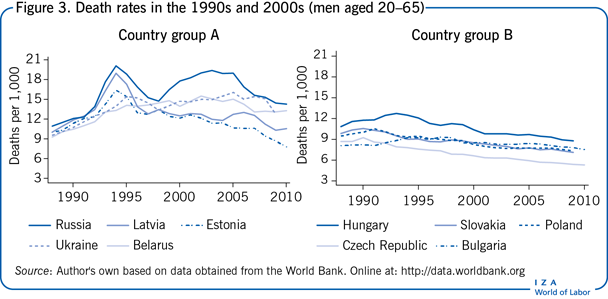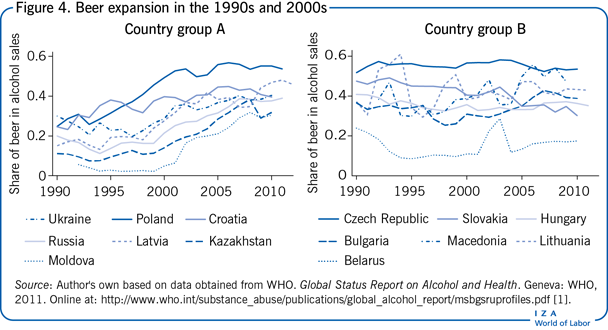Elevator pitch
Eastern European countries, particularly former Soviet Union economies, traditionally have the highest rates of alcohol consumption in the world. Consequently, they also have some of the highest male mortality rates in the world. Regulation can be effective in significantly decreasing excessive drinking and its related negative effects, such as low labor productivity and high rates of mortality. Understanding the consequences of specific regulatory measures and what tools should be used to combat excessive alcohol consumption is essential for designing effective policies.
Key findings
Pros
Price regulation in the market for alcohol has a significant effect on alcohol consumption.
Lowering levels of excessive drinking improves personal health and labor productivity (for men) and brings down mortality rates.
When there are constraints to policy, measures to promote the substitution of spirits for less harmful drinks have a positive effect.
The presence of peer effects multiplies the effectiveness of policy.
Policy that targets young adults can be particularly effective in preventing habitual alcohol consumption from developing.
Cons
Strict regulation may be politically costly, particularly for populist politicians.
Strict regulation may cause people to switch to homemade and surrogate alcohol, which can have even more harmful effects.
No studies have been conducted on the causal effect of an increase in the price of alcohol on the consumption of homemade and surrogate alcohol.
Establishing the causal effect of excessive drinking on mortality is difficult.
There is mixed evidence of a causal effect of excessive drinking on labor productivity for women.
Author's main message
Excessive alcohol consumption in many Eastern European countries leads to high mortality rates among men and has a negative effect on labor productivity. Various regulatory measures, such as taxation, sales restrictions, licensing, advertisement control, and drinking age limits, have been effective in lowering alcohol consumption. Over-regulation, however, may lead to a rise in the consumption of homemade and surrogate alcohol. Policies that encourage the substitution of spirits for safer drinks can be very effective. Likewise, policies that target youth, when habits are formed, can have beneficial long-term consequences.
Motivation
Data from the World Health Organization (WHO) show that of the 15 countries with the largest life-expectancy gap between men and women, ten are former USSR and Eastern European economies [2]. The top five are former USSR economies: Russia is highest with a gap of 14.3 years, followed by Ukraine with a gap of 11 years, and Estonia, Lithuania, and Kazakhstan, each with gaps of ten years.
This gender “mortality gap” is driven predominantly by extremely low male life expectancy. Over the last two decades, male life expectancy in Ukraine and Belarus is 63.7 and 64.5 respectively, which is below the world average of 68 years. In contrast, female life expectancy in these countries is above the world average.
Excessive alcohol consumption is frequently cited as being the main cause of extremely high rates of male mortality [3], [4], [5], [6], [7], [8], [9], [10], [11]. Country-level data in these studies show a clear correlation between alcohol consumption and male mortality. Thus, among the countries with a population of more than half a million people, 11 out of 15 with the highest levels of consumption of spirits are Eastern European and former Soviet economies, with Belarus and Russia ranked first and second, respectively [1]. Although in the last decade the situation in Eastern European and former Soviet countries has improved, largely due to tightening regulation in the alcohol markets, it is still far from ideal, and many further policy changes have to be made to improve the situation.
Determining the most effective regulation for addressing this problem is essential for policymakers. What regulatory tools are most effective in combating mortality? What groups within the population should be the main focus and target of the regulatory policy? Policymakers must also be aware of what regulatory framework and tools are most effective, if and when there are political constraints to implementing strict regulation on alcohol purchase and consumption.
Discussion of pros and cons
Lessons from recent history
Regulation can be a very effective means of combating excessive drinking and its negative consequences, such as low labor productivity and high mortality rates, particularly among men. A notable example of the effectiveness of regulatory policy on alcohol consumption is the USSR's “natural experiment” anti-alcohol campaign, which highlights the strong, causal relationship between excessive drinking and health problems.
This anti-alcohol campaign was initiated in 1985 by the USSR leader Mikhail Gorbachev. During the five years of the campaign, the production of alcohol under state control was significantly reduced. Many liquor stores were closed, sales hours were restricted, the price of alcohol was significantly increased, and many other regulations were introduced. As a result, alcohol consumption fell by more than 40% [3], [12]. Subsequently, male mortality rates in Soviet republics fell by 25%. In contrast, other communist-bloc countries, such as Bulgaria, Poland, Hungary, and the Czech Republic, which were not subject to the anti-alcohol campaign, did not experience a similar drop in mortality rates (Figure 1) [2].
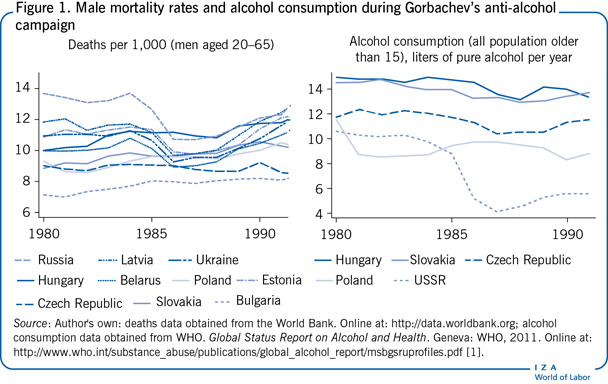
In the early and mid-1990s, immediately following the collapse of the Soviet Union, Gorbachev's campaign was discontinued, and in most transition countries the alcohol market was liberalized. As a result, populist politics and/or the inability of regulatory agencies to control the situation led to a sizable decrease in the price of alcohol relative to other goods and relative to average income. It also led to an increase in alcohol consumption by more than 50% [9].
Many studies suggest that the rapid increase in alcohol consumption during this period was the most significant contributory factor in the sudden surge in mortality rates. Its impact was even bigger than the drop in income, the effect of poor nutrition, the deterioration of the health care system, and the personal stress associated with the transition period [3], [4], [9]. This shows that cheap alcohol, coupled with an absence of any consistent regulatory policy to control excessive drinking, can have disastrous consequences.
In all former Soviet republics, alcohol consumption and mortality rates rose by more than 50% during the period 1991–1996 (Figure 2 and Figure 3). To control this surge in mortality rates, governments imposed more regulatory restrictions on the alcohol market during the period 1996–2007. These included: increasing levels of excise taxes, forbidding advertising of alcoholic drinks, restricting hours when alcohol could be sold, introducing a minimum drinking age, and various other regulatory measures. These regulations—together with another very important factor, the expansion of the beer industry—served to stop and then reverse the prevailing trends in alcohol consumption and mortality rates.
The expansion of the beer industry came as a result of opening borders and lowering trade restrictions between countries, which allowed foreign breweries to enter local markets. This, together with a lower regulatory burden imposed on the beer industry in many countries, resulted in its rapid expansion during the 2000s. As a consequence, hard liquor consumption was substituted by beer consumption [13]. As beer is a relatively safer drink compared to hard spirits, this shift led to lower rates of excessive and hazardous drinking, as well a decrease in mortality rates.
Figure 4 illustrates the expansion of the beer industry during the 1990s and 2000s. It shows that the share of beer consumption grew by more than 200% in most of the countries that initially had low levels of beer consumption. The exception is Belarus, which had a more restrictive alcohol market than the other countries.
One study provides additional evidence of the substitution effect of beer and spirits [13]. Using microdata on Russian men, the authors show that even when levels of alcohol intake are taken into account, those individuals who prefer drinking vodka have a significantly higher risk of death compared with those who prefer drinking beer (or wine). The study also shows that the substitution of vodka drinkers to beer drinkers resulted in a 15% decrease in male mortality in ten years [13].
The importance of effective regulation
The Gorbachev anti-alcohol campaign demonstrated that regulatory measures to combat excessive alcohol consumption can be effective in decreasing consumption and consequently, in reducing mortality rates. The campaign also demonstrated how these measures can be effective in addressing other negative outcomes of excessive alcohol consumption, such as low labor productivity. Evidence shows how excessive drinking can result in increased absenteeism from work, lower earnings and lower hours worked, and a greater chance of injury at the workplace [3].
Another piece of evidence comes from the recent so-called “silent” anti-alcohol campaign that started in Russia in the mid-2000s; it had the effect of ending and reversing the trend in mortality rates. After 2005, Russia gradually tightened regulation on the alcohol market. Among the measures taken were: a rise in the minimum price of vodka (since 2011), imposing evening and night closing hours for retailers (since 2006), and increasing excise taxes on all alcoholic beverages [14]. These regulations, along with changing consumption patterns due to opening trade (substitution from vodka to beer), resulted in a sizable decrease in alcohol abuse. According to the WHO, from 2005 to 2017 alcohol consumption decreased by 40%, and spirits consumption fell by 60%. As a result of this campaign, Russia has dropped from first globally in the intake of spirits to outside the top 20 countries. These changes have resulted in a significant improvement in health outcomes. Mortality rates of working-age males have dropped by 30%, and male life expectancy has increased from 65 years in 2005 to 72 years in 2018.
So, what kind of regulation should be implemented to control excessive drinking? The answer is that many policy instruments can work effectively, including: price increases, restricting sales hours and days, limiting the number of shops that are permitted to sell alcohol, licensing the production of alcohol, banning the advertising of alcoholic products, and introducing a minimum legal age for drinking alcohol [2].
Economic studies from around the world suggest that alcohol is a relatively “elastic” good, which means that its purchase is sensitive to changes in price. One study that uses differences in regional legislature as an instrument for alcohol prices finds that heavy drinking is relatively “price-elastic,” which suggests that a small increase in the price of alcohol results in a relatively large decrease in heavy drinking. Hence, increasing the price of alcohol can be an effective policy measure.
Restrictions on the availability and purchase of alcohol are also an effective policy tool. The consumption of alcohol exhibits several features that are not fully rational, for example, “time inconsistency” and “myopia.” Accordingly, people tend to underestimate how much they would like to drink in the future and so prefer not to store alcohol at home [12]. Thus, when there are restrictions on the hours and days on which alcohol can be sold, this can lead to a reduction in the extent of heavy drinking.
There are some arguments that suggest “excessive” drinking, rather than “average” drinking, should be the main target of regulatory policy. This is due to the fact that while the effect of moderate drinking, both on health and labor productivity, is ambiguous, the effect of heavy drinking is unambiguously negative. This observation is particularly important for former USSR countries, where 50% of all deaths in working-age men are caused by so-called “hazardous” or “binge” drinking [5], [6].
The downside of strict regulation
It should be understood that there are also dangers involved with too-strict regulation on the purchase of alcohol and high prices. For example, people may switch their consumption to homemade alcohol and other surrogate products (which contain alcohol but are not intended for consumption). Strict regulation may also facilitate the introduction of an illegal alcohol market. In line with this, the decrease in official sales of alcohol during Gorbachev's campaign was partly compensated for by an increase in the production and consumption of homemade vodka and surrogate alcohol [3], [7]. Nevertheless, the overall effect of the campaign was positive, in that total alcohol consumption—including legal, surrogate, and homemade alcohol—decreased.
Strict regulation of the alcohol industry may also be costly for populist politicians [9]. When there are political constraints to introducing prohibitive regulatory policies, measures that lead to the substitution of spirits for safer drinks can be quite effective in combating excessive drinking. For example, stricter regulation of hard drinks, combined with less regulation of the wine and beer industries, may not decrease the average level of alcohol consumption, but will combat excessive drinking.
Another potentially effective policy is the substitution of other activities for alcohol consumption, such as participation in sports. However, there is currently a lack of empirical evidence that demonstrates the causal effect for this relationship.
What kind of alcohol consumption is worse?
Another important question to consider is what “type” of alcohol consumption is the main cause of alcohol-related mortality? There are several types that can be considered “hazardous” drinking, such as: the quantity of alcohol consumed, the way in which alcohol is consumed (e.g. “binge” drinking), and the quality of the alcohol consumed (e.g. the consumption of surrogate alcohol). Obviously these three factors are highly correlated, which makes it difficult to distinguish between them, and the public health literature provides several views. Some studies argue that the consumption of surrogate alcohol, rather than heavy drinking per se, irrespective of what kind of alcohol is consumed, is the main source of alcohol-related mortality [5], [6].
Depending on the main target of government policy, regulators should consider selecting different strategies. For example, lowering the price of alcohol may increase the level of consumption, but it may also lead to consumers switching from the consumption of low-quality surrogate alcohol to higher-quality official alcohol. On the other hand, adding a supplement to fluids that contain alcohol spirit (such as cheap windscreen-wiper fluid) to make it non-drinkable would reduce the consumption of surrogate alcohol, but would not necessarily result in a reduction in the average level of alcohol consumption.
Younger people form alcohol habits
Another important consideration when formulating appropriate policy to combat alcoholism is that the consumption of alcohol and specific types of drinks is habit-forming. These habits can be deeply embedded and can affect personal consumption patterns even decades later. One study highlights that the expansion of the beer industry that occurred in Russia during the 1990s and 2000s affected mainly young adults who were just beginning to consume alcohol. This generation of younger people switched to consuming beer instead of spirits, whereas the older generation, who had already developed strong habits toward consuming hard alcohol, continued to drink spirits [13].
Similarly, evidence shows that a young person's initial choice of the particular type of habit-forming product (e.g. beer, vodka, or wine) affects that individual's consumption patterns later in life. For example, if an individual consumes vodka during their teens, they are much more likely to prefer drinking vodka later in life. If beer was their preference during their teenage years, then they will also be more likely to prefer drinking beer decades later [13].
Peer effects
A further and very important consideration is that alcohol is a “social” good. People like to drink in the company of others in social situations, and peer decisions on whether to drink, or not, affect personal decisions related to drinking [12]. This is particularly the case in former USSR countries. The Soviet Union left behind the legacy of communist-style apartment blocks, where people lived in close proximity to each other for the duration of their lives. This kind of settlement pattern, as well as very low social mobility, results in people interacting and socializing with their neighbors throughout their life.
The presence of peer effects implies the presence of a so-called “social multiplier.” This suggests that an increase in the price of alcohol will impact upon more people as a consequence of peer influence. For example, a government policy, such as a rise in the taxation of alcohol, will not only affect one individual by encouraging them to consume less, but will also have a spillover effect on their peers, in that they will also drink less.
Peer effects are especially strong among younger generations. For example, one study shows that for males younger than 30, the peer effect increases the price elasticity of alcohol consumption by 50%. This means that a government policy such as an increased alcohol tax should generate a 50% higher decrease in alcohol consumption for the younger generation [12].
Hence the importance and potential effectiveness of government policy targeted toward the younger generation is twofold. First, policy measures directed at the young will have a stronger effect, due to stronger peer effects and the absence of habits. Second, this effect will be very long-lasting, as future consumption is clearly influenced by habits formed during teenage years.
Finally, lowering the level of excessive drinking will have positive outcomes for health as well as for labor productivity. Evidence supports the presence of a negative relationship between excessive alcohol consumption and labor productivity, particularly for men, as heavy drinking can result in increased absenteeism, lower earnings and less hours worked, and more risk of workplace injury.
Limitations and gaps
The data on alcohol consumption are poor. In individual-level surveys, people tend to under-report, or mis-report, their personal levels of alcohol consumption. National statistics, particularly during the Soviet period prior to 1989, also provide poor information, especially on the consumption of homemade alcohol.
Although there is a well-documented correlation between excessive drinking and mortality rates in Eastern European countries, the causal link is difficult to establish and measure. There are several reasons for this. First, access to relevant data is difficult: deaths are rarely studied in empirical research, since it is difficult to collect reliable data on a person who is no longer alive. Second, heavy drinking is usually accompanied by other risky behavior and activity, such as smoking and drug consumption, which also affect mortality. In addition, people from poorer neighborhoods, with high crime rates and a lack of access to health care, and so on, are more likely to indulge in heavy drinking. Finally, individuals could reduce their consumption levels when they become sick and face a high chance of dying. Only one study goes further than others in establishing the causal relationship between heavy drinking and mortality [6]. Similar problems exist in trying to establish the causal effect of alcohol consumption on labor productivity.
Likewise, establishing the causal effect of regulation and high prices on alcohol consumption is also difficult, as a high level of tax on the purchase of alcohol is often set in response to a high level of alcohol consumption.
Evaluating the effect of a particular regulation is also problematic, as most regulatory measures are typically imposed simultaneously. For example, a high excise tax on alcohol is usually accompanied by sales-time restrictions, or restrictions on advertising.
Finally, several important policy-related questions have not yet been sufficiently studied. For example, it may be more efficient and effective to introduce a “bundle” of regulations simultaneously. However, the effect of such “policy bundling” has not been studied. Similarly, the causal effect—if indeed there is one—of promoting substitution activities for alcohol consumption, such as sports, has not yet been sufficiently studied to come to any firm conclusions.
Summary and policy advice
Eastern European countries, particularly former Soviet Union economies, traditionally have the highest rates of alcohol consumption in the world; they also have some of the highest male mortality rates in the world. There is a clear relationship between excessive drinking and very high mortality, so policies need to be implemented to combat both excessive drinking and excessive mortality.
Various regulatory measures that have been implemented in many countries around the world seem to be effective in reducing alcohol consumption and high mortality rates. These include: price increases for the purchase of alcohol (through excise taxes), restricting the hours and days on which alcohol can be sold, licensing the production of alcohol, banning or limiting the advertising of alcohol products, and introducing a minimum legal drinking age.
However, over-regulation of the alcohol industry can lead to an increase in the consumption of homemade and surrogate alcohol products. Therefore, supplementary policy measures that increase the cost of consumption of these alternative products could be useful. Different strategies could be selected depending on the main target of government policy. For example, although lowering the price of alcohol would result in an increase in consumption, it may also lead to consumers switching from drinking the more harmful low-quality surrogate products to consuming higher-quality official alcohol instead. On the other hand, policies that successfully reduce the consumption of surrogate alcohol may not necessarily have the effect of reducing the average level of alcohol consumption.
To prevent people from switching to the consumption of homemade and surrogate alcohol instead of legal, higher-quality alcohol, policymakers could also choose to decrease the regulatory burden imposed on lighter alcoholic beverages, such as beer and wine. As beer and wine are less harmful to people's health than spirits, this policy could have positive public health benefits.
Finally, alcohol is a habit-forming good, as well as a “social” good. An increase in the taxation of alcohol will not only affect one individual (by encouraging him or her to consume less), but also have a spillover effect on his or her peers, which would result in them also consuming less alcohol. This spillover effect is observed particularly in young adults, where targeted policy measures have a stronger effect due to stronger peer effects and the absence of habits. The impact of such policies can be very long term, as future consumption is clearly influenced by habits formed (or not formed) during teenage years. This suggests that the younger generation should be one of the main targets of policy measures designed to reduce excessive drinking and the consequent high rates of mortality.
Acknowledgments
The author thanks an anonymous referee and the IZA World of Labor editors for many helpful suggestions on earlier drafts. Previous work of the author contains a larger number of background references for the material presented here and has been used intensively in all major parts of this article [13]. Version 2 of the article provides an update on the effects of regulations in Russia and adds new “Key references” [13], [14].
Competing interests
The IZA World of Labor project is committed to the IZA Code of Conduct. The author declares to have observed the principles outlined in the code.
© Evgeny Yakovlev
